The Razer Blade Stealth Review: Razer Takes On The Ultrabook
by Brett Howse on March 29, 2016 8:00 AM EST- Posted in
- Laptops
- Razer
- Skylake
- Razer Blade Stealth
- eGFX
- Razer Core
- Skylake-U
Battery Life
Mobility goes hand-in-hand with battery life. The Razer Blade Stealth certainly fits the mobility part, with a small, thin, and light design which would be easy to take with you. But if you have to bring the charger with you, it’s less convenient. We’ve seen some impressive battery life numbers on Ultrabooks and other low-profile devices over the last couple of years, with the Dell XPS 13 and Microsoft Surface Book both hitting over 15 hours on our light test.
The Stealth has a slightly smaller than average battery size, at 45 Wh. I would say the average for an Ultrabook of this size would be around 50 Wh, with a couple below and a couple above. This is going to be a factor against the Stealth right out of the gate. The other factor against it is the high resolution display offerings. Baseline Ultrabooks generally come with a 1920x1080 display, and the lowest offered on the Stealth is a 2560x1440. The top model is 3840x2160, or four times the pixels of a 1080p display. This not only is more work to render images on for the GPU, the transistors used to drive the pixels also block the backlighting, necessitating a brighter, more power-hungry backlight.
We measure battery life with two standardized tests. The light test is simply web browsing, with the display set to 200 nits brightness. The heavy test loads many more pages, adds in a movie playback, and includes a 1 MB/s file download to keep the wireless NIC active. For 2016, these tests may be adjusted, but for now the existing tests give us lots of data points against previously tested devices. All browsing is done with Microsoft Edge as the browser, and keyboard backlighting is disabled.
Light Battery
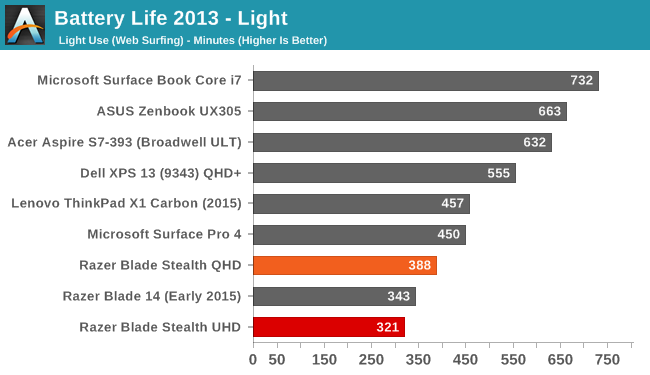
This, well there’s no way to sugar coat this. This is poor battery life for an Ultrabook in 2016. The UHD model unsurprisingly suffers even more than the QHD version, but both are below average. At just about 6.5 hours on the QHD one, it is getting very close to the same battery life as the Razer Blade 14, which is a full-fledged gaming notebook. The UHD model is 67 minutes less. If you are after the ultimate in mobility, then the Razer Blade Stealth is not the notebook for you.
Heavy Battery
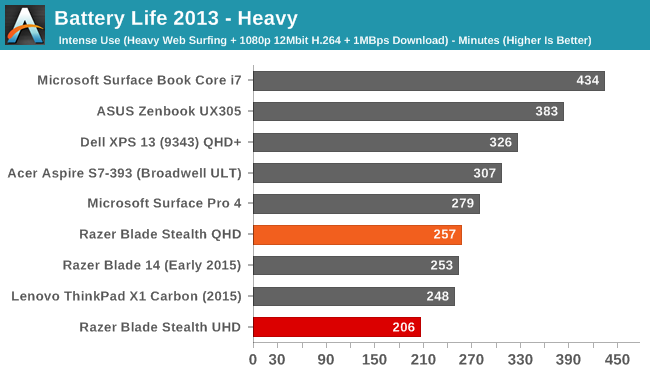
Adding in more CPU, NIC, and GPU shifts the balance on power draw away from the display, which is the main power draw on the light test. This pulls the UHD model a bit closer to the QHD version, with it only 51 minutes behind this time. But regardless, these heavy load times are far from the top of the Ultrabook class.
Normalized Battery Life

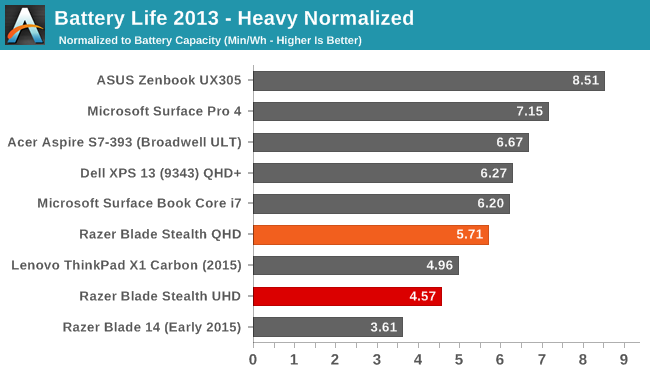
Removing the battery size from the equation gives us a better look at platform efficiency, since low efficiency can’t be masked by larger battery sizes in these scores.
The Stealth clearly has some work to do on efficiency. The best devices in the Ultrabook category can be in the 10-14 minutes per Watt-Hour range on the light test, and even the QHD version of the Stealth is only at 8.6. On the heavy test, it fares a bit better, but is still below the other devices.
This is Razer’s first kick at the can when building an Ultrabook. On the Razer Blade 14, the battery life is pretty decent for a gaming laptop. There are plenty of high draw components like a discrete GPU and quad-core processor to mask smaller inefficiencies of the platform. But, when looking at Ultrabooks, Razer is up against some of the biggest OEMs out there, and whom all are trying for that elusive top battery life score. There are missteps by the OEMs too, such as Dell having an issue with NVMe storage not going to sleep, which was later fixed with a BIOS update, but Razer needs to look at their platform at a component by component basis, and strive for better. Getting six or so hours out of a gaming notebook like the Blade 14 is pretty decent, but an Ultrabook in 2016 needs to be at least eight.
As an experiment, the Stealth was left running idle at the desktop at 200 nits, with just a script running to log the time every two minutes. Here it only got just 8:17, barely a squeak over eight hours, and this is with it doing nothing at all. Not everyone needs long battery life, but it’s going to be on a lot of people’s list when considering a notebook, so hopefully this will be addressed for future models.
Charge Time
The other half of the equation is charge time. This is generally limited by the AC adapter shipped with the device. In this case, that’s a 45-Watt adapter, and Razer uses the USB-C port as the charging port. The design of the charger is quite nice too, with a braided cord on the USB end and a very small adapter. One issue I’ve had with the charger though is that there is noticeable coil whine from the adapter, especially when the laptop is charged but plugged in. I’ve actually got three adapters, and all of them have some coil while, although one of them is significantly louder than the others.
Moving on the charging times, the charging time test is done with the machine idle at the desktop, and the display set to 200 nits again. Charge times are from whatever the laptop shuts off at (generally 5% battery) to 100% charge. Most devices charge pretty quickly up to 99%, and then trickle charge the last percent, so a charge graph is provided as well.
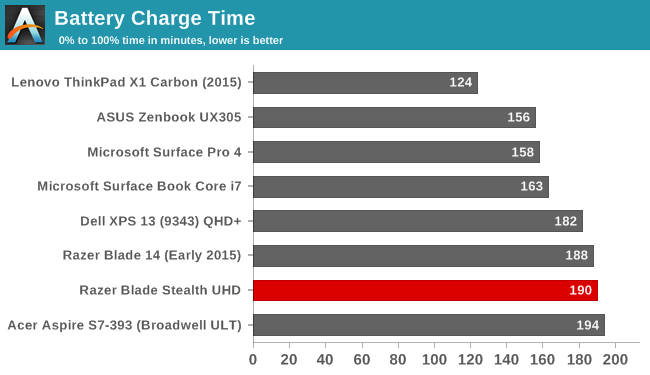
At 190 minutes, the Stealth is amazingly right around the same time as the Blade 14. The similarities seem to never end, but the result is below average but not a huge amount.
It’s great to see Razer go with a USB-C charging cable. For most laptops, the 100-Watt power availability from USB-C is going to be enough, meaning there’s a good chance laptop cords will finally be universal. In fact, it’s very convenient that I can already charge this laptop with the same cord that I use for my phone, and vice versa, and especially when travelling it’s nice to see a move to a standard charging connector.
This section is not the strongest part of the Stealth. Battery life has been sub-par and the charging speed is below average as well, and compounded by a power supply that is not inaudible. It’s well designed aesthetically but the coil whine is annoying to the point where I disconnect the laptop when its charged.


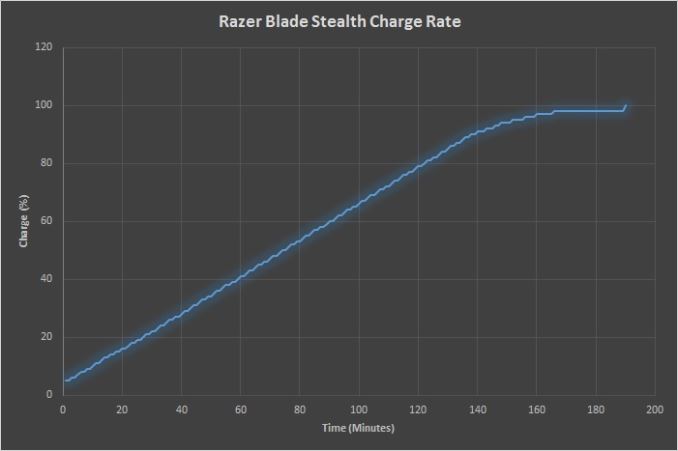








66 Comments
View All Comments
bug77 - Wednesday, March 30, 2016 - link
Hear, hear!My desktop has it's place and is the only device I game on (save for PvZ2 on my old tablet).
lmcd - Tuesday, March 29, 2016 - link
While the battery life isn't mind-blowing, I wish the storage tiers went 900-1100-1300-1500. Six hour battery life, while bad by comparison, is still more than the average person's working time away from the desk and wouldn't limit most of the people interested in this.jcbenten - Tuesday, March 29, 2016 - link
The thick bezel makes it look old. After seeing the XPS and Surface Book I could not stand to look at this screen.nagi603 - Tuesday, March 29, 2016 - link
Yeah, that bezel looks thicker than that of my old 2004 gaming laptop...Naql99 - Tuesday, March 29, 2016 - link
I bought one of these for my son. First power adapter was defective out of the box. The usb-c connector would not 'snap' into place. Returned it and the replacement unit broke in about 2 weeks when the tip fell out of the end of the cable. I assumed my son was at fault, so I purchased another for the princely sum of $140. The tip fell out of that one within 3 days. Razer refused to replacement. Well, sorry, but cannot afford to keep shelling out $140 a pop for charging bricks and they clearly have a build quality defect. Sure, the colored backlit keys are pretty, but Razer quality is sub-par and their support let me down. We ended up buying an Innergie charger for $40 that works, even though Razer support warned me that using it instead of their crappy $140 chargers would 'void my warranty'. Ok, your warranty isn't worth squat. May I recommend the dell xps precision laptops which are also eGPU capable. As for the Core, it does not even offer a thunderbolt pass-thru, so how can that be considered an actual docking unit. There will be other eGPU solutions soon. I would wait. Buyer beware. Out of the two months my kid has had it, he's only been able to use it for maybe 2 weeks.DanNeely - Tuesday, March 29, 2016 - link
It has a bunch of USB ports, an ethernet port, and a bunch of video out ports. That looks like a standard docking station to me. If I were to criticize it for anything, a lack of audio ports would be my biggest grumble.Not including TBs optional passthrough feature was probably a deliberate decision to limit competition for bandwidth the GPU needs. An x4 PCIe connection is enough that most games will run at almost full speed; only an x1 will strangle a large fraction of them. Even with just USB+ethernet you could end up oversaturating TB3: 32gb for PCIe, + 4x 5gb for USB3 + 1gb for ethernet is 53 gb vs TB3's 40gb. In practice that's unlikely to be a major concern; not least because 1 or more of the USB ports would typically be filled with low bandwidth devices (keyboard, mouse, usb headset); and USB3 devices capable of maxing the bus speed for sustained periods of time are relatively uncommon. Chaining a second high bandwidth TB device OTOH could be problematic; giving it half the total bandwidth would hurt the GPU in a significant number of games. Things that would fall under the category of "clever^H^H^H^H^H^Hstupid user tricks" like chaining a TB3 monitor and having it run off the laptops IGP (either due to misconfiguration, or not having video pass through support for the docs GPU due to cost or hardware limitations) could also end up burning people.
IMO with GPUs in the mix any sort of daisy chaining would need to wait for a future standard that supports at least 8x PCIe.
Naql99 - Tuesday, March 29, 2016 - link
I see your point, but I have a significant number of thunderbolt devices. I need to be able to hook up my external disks. In general, it is frustrating that there are so many thunderbolt devices that insist on being the the last device in the chain. In any case, I would have purchased the Core, if not for the support/wuality issues noted above.jsntech - Tuesday, March 29, 2016 - link
Razer has made enough missteps for me (Synapse 2.0, numerous failed devices which were very gently used) that despite the decent form factor competing pretty nicely with rMBP 13 and such, I won't even consider it (not to mention 16:9 is *especially* poorly suited on a 12.5" display).jsntech - Tuesday, March 29, 2016 - link
Er, the MB is probably a better comparison.TheinsanegamerN - Tuesday, March 29, 2016 - link
For that price, I would have expected for them to use the i7 6560u with the iris 540 gpu, and have better battery life. This thing is just a normal uber expensive ultrabook without the dock, at least with iris it could stand on its own a bit.